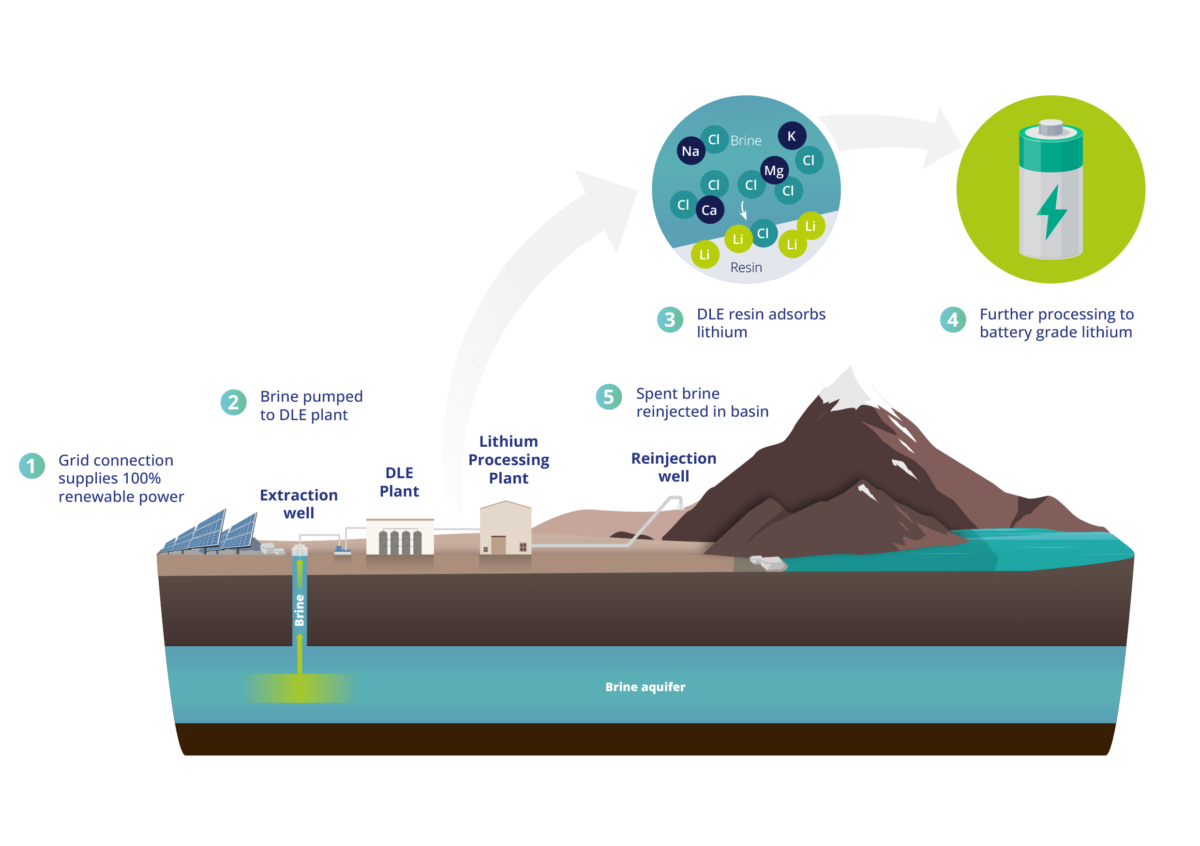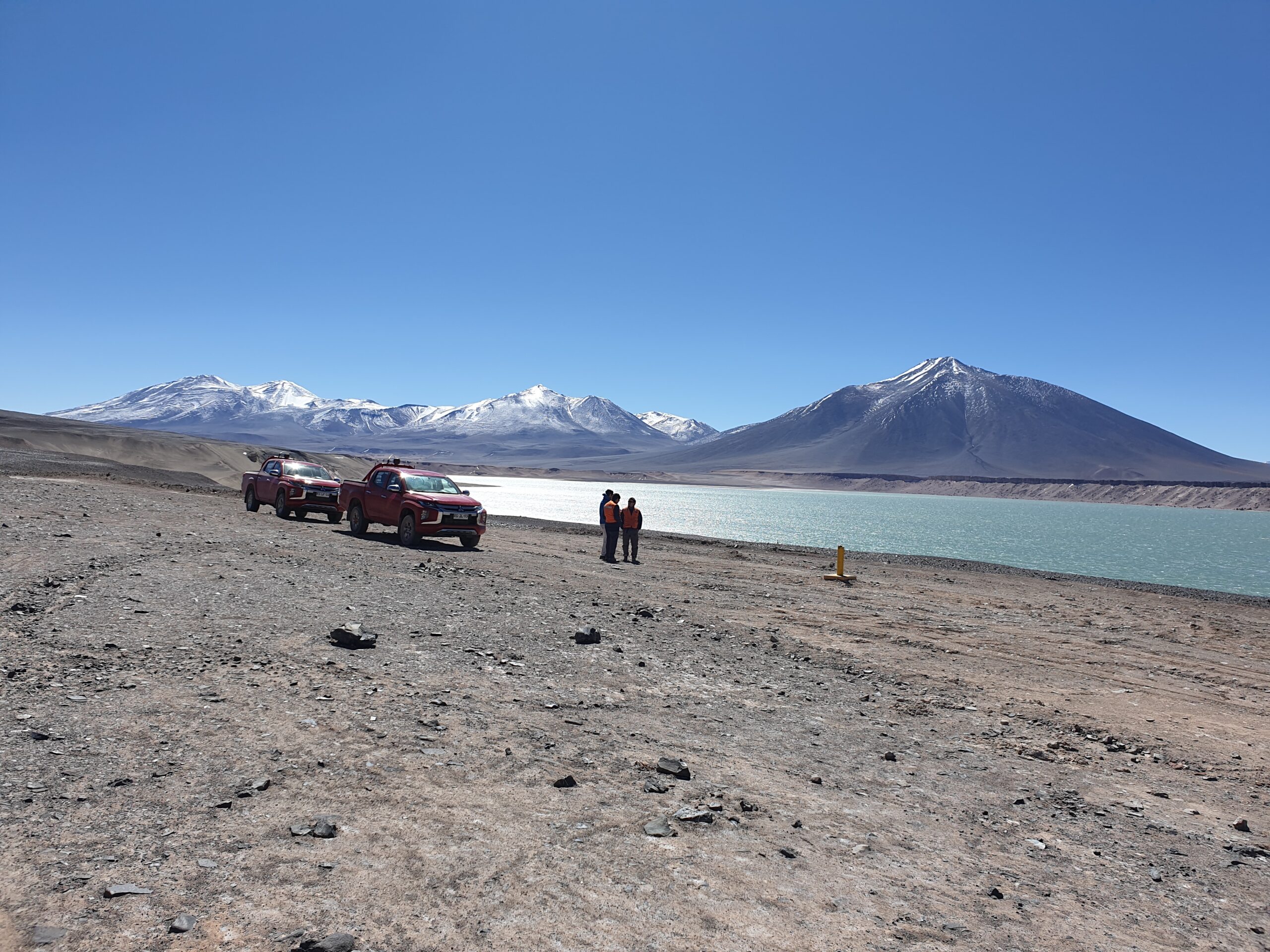DLE is moving into the mainsteam
Process overview
Direct Lithium Extraction (DLE) is a proven technology, with established producing projects based on DLE in China and South America. Brine is extracted from the basin aquifer and pumped to a processing unit where a resin or adsorption material is used to extract only lithium, while spent brine is reinjected into the basin aquifers with no aquifer depletion or harm to the environment. The resin adsorbs lithium chloride (LiCl) molecules onto the surface of the material, which is then stripped using water creating a lithium eluate. This eluate is then further concentrated via reverse osmosis and mechanical evaporation stages before standard industry processes are used to produce battery-grade lithium.

To power this, it is our plan to connect to Chile’s renewable energy grid to be 100% powered by clean energy. We believe that this, in tandem with utilising DLE technology, lays solid foundations to deliver ‘green’ lithium supply for the EV and battery manufacturing market. DLE is a proven and established technology within the lithium sector, having been utilised for several decades at the Hombre Muerto project in Argentina, operated by Livent. This is the second largest lithium production operation in the world with an annual capacity exceeding 20,000 tonnes per annum (tpa) of Lithium Carbonate Equivalent (LCE). In China, there are three commercial DLE operations in production, all of which have utilised the technology of Direct Lithium Extraction with China‘s leading DLE technology provider, Sunresin, which is our primary process technology partner.

Additionally, there are numerous development stage lithium projects around the world that have completed feasibility studies based on utilising DLE.
A green approach to lithium extraction:
- Minimal harm to environment
- No aquifer depletion
- Low-CO2 emissions
- Low-water consumption
- Powered by renewable energy
Most lithium production from brine is produced via evaporation pond-based operations which have a large environmental footprint, depleting basin aquifers and reducing groundwater levels which impacts access for local communities. Chile’s existing lithium production is produced with evaporation ponds at Salar de Atacama, where over 100m3 of brine is evaporated to produce one tonne of LCE. The DLE process and reinjection of spent brine aims to reduce net water consumption to less than 2m3 per tonne of LCE, or 50 times less than existing production in Chile. This addresses a key concern regarding the sustainability of lithium extraction in Chile. We have demonstrated the benefits of using DLE to the Chilean government and mining authorities as well as to car and battery manufacturers. We believe that DLE technology will advance the interests of national and local governments in tandem with local communities by providing economic opportunities and green jobs.
With the evaporation ponds, the water depleted from the aquifer is not recharged.
This has proven to have significant environmental consequences for the surrounding area, including at Salar Atacama, the world’s largest lithium production base, also located in Chile. We have noted strong support from the Chilean government mining authorities for our DLE based extraction plan.
Having completed trials with several DLE technology providers and conducted tests that have produced favourable results we have loaded Lanshen’s adsorbent into the DLE pilot plant, built by Sunresin, which is in the process of being commissioned.

Green lithium
We intend to use renewable power wherever possible for our operations. This is achievable through grid connection, the development of renewable energy in the project areas, or a combination of both options.
![Ctl Map[7]](./direct_files/CTL-Map7.png)
Our projects are ideally located to utilise either grid or solar power.
The Chile grid runs close to our flagship projects, with sub-stations and branch transmission lines offering relatively easy connectivity. The grid has one of the highest renewable energy components of any national grid, with excellent sources of solar, wind, geothermal and installed hydroelectric power all feeding into the grid system.
Our most advanced project, Laguna Verde, also offers the potential for geothermal energy, which is a highly efficient method of producing heat for the DLE process.
While site based renewable energy will be evaluated during the feasibility studies planned, the base case of utilising the existing capacity of the central Chilean grid, via connecting to a nearby substation, provides a readily available opportunity with low emissions potential.
